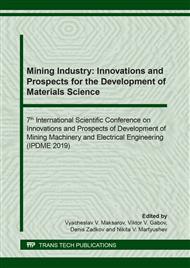[1]
H. Nikam Sagar, K.J. Neelesh, Finite Element Simulation of Pre-Heating Effect on Melt Pool Size During Micro-Plasma Transferred Arc Deposition Process, IOP Conf. Ser.: Mater. Sci. Engineer. 389 (2018) 012006.
DOI: 10.1088/1757-899x/389/1/012006
Google Scholar
[2]
K.A. Mitin, V.S. Berdnikov Radiation-convective heat transfer from the crystals in methods of pulling from melts, J. Phys.: Conf. Ser. 1105 (2018) 012027.
DOI: 10.1088/1742-6596/1105/1/012027
Google Scholar
[3]
Investigation of Sensible and Latent Heat Storage System using various HTF.
Google Scholar
[4]
N. Beemkumar, A. Karthikeyan, A. Manoj, IOP Conf. Ser.: Mater. Sci. Engineer. 197 (2017) 012038.
Google Scholar
[5]
U. Sharikov, A. Marcus, Mathematical modeling of heat flows in pipelines and tubular objects, Notes of the Mining Instit. 202(3) (2016) 235.
Google Scholar
[6]
Yu. Sharikov, I. Beloglazov, Mathematical modeling of emergency situations during storage and processing of potentially hazardous chemicals, Notes of the Mining Instit. 187(3) (2016) 151.
Google Scholar
[7]
Yu.G. Soloveichik, M.E. Royak, M.G. Persova Metod konechnykh elementov dlya resheniya skalyarnykh i vektornykh zadach (Finite Element Method for Solving Scalar and Vector Problems), Novosib. Gos. Tekh. Univ., Novosibirsk, (2007).
Google Scholar
[8]
V.A. Francis, N. Hewitt, P. Eames, M. Smyth, A review of materials, heat transfer and phase change problem formulation for latent heat thermal energy storage systems (LHTESS), Renewable and Sustainable Energy Reviews 14 (2010) 615–628.
DOI: 10.1016/j.rser.2009.10.015
Google Scholar
[9]
M. Auriemma, A. Iazzetta Numerical analysis of melting of paraffin wax with Al2O3, ZnO and CuO nanoparticles in rectangular enclosure, Indian J. of Sci. and Technol. 9 (2016).
DOI: 10.17485/ijst/2016/v9i3/79806
Google Scholar
[10]
B. Zalba, J.M. Mann, L.F. Cabeza, H. Mehling, Review on thermal energy storage with phase change: materials, heat transfer analysis and applications, Applied Thermal Engineer. 23 (2003) 251–283.
DOI: 10.1016/s1359-4311(02)00192-8
Google Scholar
[11]
V. Ankudinov, G.A. Gordeev, M.D. Krivilyov, Numerical simulation of heat transfer and melting of Fe-based powders in SLM processing, IOP Conf. Ser.: Mater. Sci. Engineer. 192 (2017) 012026.
DOI: 10.1088/1757-899x/192/1/012026
Google Scholar
[12]
E. Kharanzhevskiy, M. Krivilyov, The Physics of Metals and Metallography 111 (2011) 53–61.
Google Scholar
[13]
W.E. King, A.T. Anderson, R. Ferencz, Metal, Applied Phys. Reviews 2 (2015) 041304.
Google Scholar
[14]
D. Herlach, P. Galenko, D. Holland-Moritz, Metastable Solids from Undercooled Melts Materials Series, Pergamon, Amsterdam, (2007).
DOI: 10.1016/s1470-1804(07)80023-x
Google Scholar
[15]
A. Matveichev, A. Jardy, J.P. Bellot, A full 3D model of fluid flow and heat transfer in an E.B. heated liquid metal bath, IOP Conf. Ser. Mater. Sci. Engineer. 143 (2016) 012019.
DOI: 10.1088/1757-899x/143/1/012019
Google Scholar
[16]
G.-X. Wang, E.F. Matthys, Mathematical simulation of melt flow, heat transfer and non-equilibrium solidification in planar flow casting, Modelling Simul. Mater. Sci. Engineer. 10 (2002) 35.
DOI: 10.1088/0965-0393/10/1/304
Google Scholar
[17]
N.N. Panasenko, P.V. Yakovlev, M.F. Rudenko et al., Strength of Carrier Structures of Maritime Ships and Port Facilities Under the Impact of Lightning, Int. Conf. on Modern Trends in Manufact. Technol. and Equipment, vol. 11, Part 1, p.580–585, (2018).
DOI: 10.1016/j.matpr.2019.01.032
Google Scholar
[18]
T.H. Kean, N.A.Ch. Sidik, J. Kaur, Numerical investigation on melting of Phase Change Material (PCM) dispersed with various nanoparticles inside a square enclosure, IOP Conf. Ser. Mater. Sci. Engineer. 469 (2019) 012034.
DOI: 10.1088/1757-899x/469/1/012034
Google Scholar


